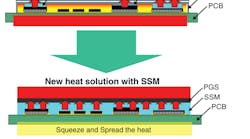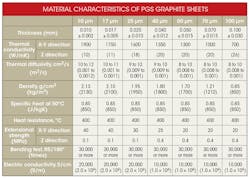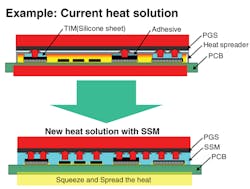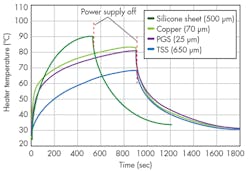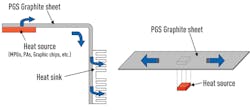Pyrolytic Graphite Sheet Evolves to Meet Tough Thermal Demands
This file type includes high resolution graphics and schematics when applicable.
If you’ve spent any time trying to manage heat in electronic devices, you may already know about the pyrolytic graphite sheet (PGS) (see “What is PGS?” below). With thermal-conductivity values as high as 1950 W/m•K when properly oriented, PGS is one of the most effective heat-spreader materials available. It’s also as thin as 10 microns and flexible, making it easier to manage heat in tight spaces or even around curves. Thanks to these properties, PGS has proven itself useful in a variety of heat-spreading and thermal-interface applications.
But no thermally conductive material is perfect, and PGS has traditionally been hampered by some limitations. For one, its highly anisotropic structure means that those great thermal conductivity values apply only to the x-y plane—conductivity drops to as little as ~20 W/m•K in the z axis.
Secondly, though the material is flexible, it’s not particularly conformal. So in practice, PGS requires some applied pressure or clamping to close any air gaps between it and the electrical component in thermal-interface applications. Clamping, in turn, can drive assembly complexity and cost.
What is PGS?
Pyrolytic graphite sheet (PGS) emerges from a sintering process that heats a polymer film to its decomposition temperature in the absence of air. The first firing converts the polymer to carbon. A second firing sets the hexagonal carbon-ring-array graphitic structure.
When performed under the right conditions, this pyrolysis process creates a highly oriented graphite material that’s close to a single crystal thick. Delivered as sheets of varying thicknesses, pyrolytic graphite has thermal-conductivity properties two to five times better than copper. PGS also exhibits robust mechanical properties— in particular, its resistance to bending stresses.
Engineers have found ways to work around these limitations, and PGS remains a valuable weapon in the thermal-management arsenal. Now, it’s about to get even more valuable.
Recent technology breakthroughs promise to make PGS more effective by combining it with other types of thermal materials to create hybrid thermal solutions. One breakthrough involves improvements to the material’s heat-spreading capabilities. Another relates to the temporary storage of heat surges. A third makes PGS more conformal to the circuit board, transforming the material into a viable replacement for gap pads and other thermal-interface materials. Here’s a closer look at all three solutions:
Enhanced Thermal-Interface Material
While PGS does feature lots flexibility in terms of bending, it doesn’t conform to the contours of all the components on a typical populated circuit board. Or more accurately, it doesn’t conform without some persuasion in the form of some clamping pressure. Clamping, however, drives assembly complexity and cost.
A new combination of PGS with a conformal material keeps things simple. The new semi-sealing conformal material, which is made from a thermally conductive thermoplastic, adheres to a PGS layer of varying thicknesses. In use, the semi-sealing material installs directly over populated circuit boards or other electronic devices, filling in any thermal dead zones and transferring heat to the PGS for further dissipation.
Together, the PGS and semi-sealing material can take the place of and outperform gap-pad thermal spreaders (Fig. 1).
Temporary Heat Storage
Sometimes you want to move the heat, but other times you want to store it. Consider, for example, a CPU whose temperatures intermittently spike under heavy processing loads.
In this case, storing the excess heat and delaying temperature rise for a few minutes can prevent CPU under-clocking or thermal-shutdown measures. This delay has practical implications for many increasingly common desktop and mobile applications, including video.
To address this problem, Panasonic’s development team embedded PGS with a proprietary phase-change material. The PGS plays its usual role in distributing heat across a larger surface area while the heat-storage material on the surface of the PGS temporarily absorbs heat.
Delay time can be substantial. In tests using a 3.5-W heat source in a cell-phone-sized enclosure, the use of PGS plus the heat-storage material extended the time to reach 60ºC by about 430% (100 s to 430 s). It also reduced heater temperature by about 17% after 1000 seconds compared to PGS alone. The PGS plus heat-storage material also bested copper foil and silicone sheet
(Fig. 2).
More Effective Heat Spreading
In today’s small powerful electronic devices, you can’t stop the heat, but you can control where it goes. PGS has a well-recognized role when it comes to shifting or spreading heat. Depending on how you apply it, PGS can transport heat in a more or less linear fashion—for example, away from a hot integrated circuit to a heat sink elsewhere in the device (Fig. 3). Or it can evenly distribute heat across a larger surface area, eliminating hotspots (Fig. 4).
While PGS alone does a good job of these heat-transport and heat-spreading applications, Panasonic’s engineering team has been working on ways to improve the efficiency of PGS. Evolutionary approaches include the ongoing development of thinner PGS layers and the creation of a stacked structure that increase the quantity of heat that can be transported (see “Is Thinner Better?”).
A more revolutionary approach involves the combination of PGS with a proprietary nano silica balloon insulator called NASBIS. Structured into nanoscale hollow particles, this highly porous material has a thermal conductivity of 0.02 W/m•K, making it an excellent insulator. In this application, we impregnate the NASBIS into a PET sheet and adhere it to PGS layers of various thicknesses.
NASBIS limits the conductive heat transfer in the PGS layer’s z-direction. While that z-direction conductivity in PGS amounts to just a fraction of the x-y conductivity, the effect of the NASBIS on overall thermal management within an electronic enclosure can be significant. Tests show more than a 20% reduction in the enclosure’s surface temperature compared to the use of PGS alone. This allows heat to be channeled by PGS and isolated from sensitive areas by NASBIS.
Is Thinner Better?
It may seem counterintuitive, but thinner pyrolytic graphite sheets actually have the best thermal-conductivity values. The conductivity edge for thin sheets stems from their highly crystallized, high-density structure, which increases thermal diffusivity.
Panasonic recently introduced a 10-micron PGS with a thermal conductivity of 1950 W/m•K in the x-y plane. A 100-micron sheet, by contrast, would have a thermal conductivity of 700 W/m•K, still far better than copper, but not on par with the 10-micron sheet.
So thinner is better, right? Well, not always. Thicker PGS sheets have a larger cross-sectional area, which allows them to carry a larger amount of thermal energy than a thinner sheet with better thermal-conductivity values. To get around limitations in the amount of heat a single thin or thick sheet can handle, Panasonic developed stacked PGS structures.
Stacking adhesive-bonded layers of thin PGS provides the thermal-conductivity advantages of a thin sheet and the high heat-transfer capacity of a thicker sheet. These stacked structures can dramatically increase the quantity of heat we can move. A 110-micron-thick stacked PGS, for example, can carry 2.3 times more heat than a single-layer PGS of the same thickness.
From improved thermal interface performance to temporary heat storage to more effective heat spreading, PGS technology continues to improve. The key to making an already useful material even better is a new hybrid approach that combines PGS with complementary thermal-management materials.
Visit Panasonic for more information on these new technologies.
